Solving Fractional-Order Diffusion Equations in a Plasma and Fluids via a Novel Transform
Abstract
Motivated by the importance of diffusion equations in many physical situations in general and in plasma physics in particular, therefore, in this study, we try to find some novel solutions to fractional-order diffusion equations to explain many of the ambiguities about the phenomena in plasma physics and many other fields. In this article, we implement two well-known analytical methods for the solution of diffusion equations. We suggest the modified form of homotopy perturbation method and Adomian decomposition methods using Jafari-Yang transform. Furthermore, illustrative examples are introduced to show the accuracy of the proposed methods. It is observed that the proposed method solution has the desire rate of convergence toward the exact solution. The suggested method’s main advantage is less number of calculations. The proposed methods give series form solution which converges quickly towards the exact solution. To show the reliability of the proposed method, we present some graphical representations of the exact and analytical results, which are in strong agreement with each other. The results we showed through graphs and tables for different fractional-order confirm that the results converge towards exact solution as the fractional-order tends towards integer-order. Moreover, it can solve physical problems having fractional order in different areas of applied sciences. Also, the proposed method helps many plasma physicists in modeling several nonlinear structures such as solitons, shocks, and rogue waves in different plasma systems.
1. Introduction
The integer-order differentiation operators are used to study local phenomena, whereas fractional-order operators are used to studying nonlocal phenomena [1]. The mathematical groundwork for fractional-order derivatives was laid by the collective struggles of various mathematicians, such as Riemann, Liouville, Caputo, Podlubny, Miller, and Ross. Afterward, numerous mathematicians dedicated their efforts to this area. Fractional calculus (FC) can be described as very successful in many phenomena in applied sciences, fluid mechanics, physics of plasmas [2, 3], and other biology utilising mathematical tools of FC. [4, 5]. Other numerous applications of FC in the field of science and technology are related to solid mechanics [6, 7], anomalous transport [8], continuum and statistical mechanics [9], economics [10], relaxation electrochemistry [11], diffusion procedures [12], complex networks [13, 14], and optimal control problems [15, 16].
Fractional differential equations (FDEs) have gotten a lot of attention from researchers in the last decade due to their ability to improve real-world challenges in different areas of engineering and physics. Mathematicians used various methods described based on the above applications to solve different important fractional-order differential equations (FDEs), mainly partial differential equations of fractional-orders (FPDEs). FPDEs are fundamental mathematical approaches that can be utilized to model different physical models more accurately than integer-order models. Nonlinear FPDEs define various phenomena in engineering, plasma physics, and applied sciences. Especially, nonlinear FPDEs are the preeminent tools to be used in various areas, for example, electrochemistry [17], mathematical social dynamics [18, 19], signal processing [20], informatics [21], traffic model [22], theory of solitons in plasma physics [23], biology [24], and much more [25–28]. Moreover, many authors reduced the fluid plasma equations to FDEs for studying the impact of derivative time-frational on the profile of nonlinear structures in a plasma [2, 3]. For instance, El-Wakil et al. [2] reduced the basic equations of a collisionaless unmagnetized nonthermal plasma having cold inertial electrons and inertialess nonthermal electrons as well as stationary positive ions to a normal KdV equation. After that, the authors use a suitable transformation to convert the normal KdV equation to a time-fractional KdV equation in order to investigate the time-fractional on the profile of electron-acoustic (EA) solitons. Furthermore, the basic equations of an ultrarelativistic plasma were reduced to the normal cylindrical Kadomtsev–Petviashvili (CKP) and cylindrical modified KP (CmKP) equations using a reductive perturbation techniques [3]. Posteriorly, the mentioned equations were converted into space-time fractional CKP and CmKP equations using one of the proper transformations in order to study the influence of space-time fractional domain of the characteristics of the ion-acoustic waves (IAWs) in the ultrarelativistic plasma. The authors made a comparison between the integer- and fractional-order models and found that the fractional-order model gives description to the IAWs in the ultrarelativistic plasmas better than the integer-order model [3]. In literature, different methods are implemented for solving FDEs, such as Iterative Laplace Transform method (ILTM) [29, 30], Approximate-analytical method (AAM) [31], Homotopy Analysis method (HAM) [32], Variational Iteration method (VIM) [33], Elzaki Transform Decomposition method (ETDM) [34], the Differential Transformation method (DTM) [35], and the homotopy perturbation method (HPM) [36, 37].
In literature, there is lot of transformations [38–40], but in this article, we implement the Homotopy Perturbation Jafari-Yang Transform Method (HPYTM) and Jafari-Yang transform decomposition method (YTDM) for the analysis of fractional-order diffusion equations. Xiao-Jun Jafari-Yang introduce the Jafari-Yang transformation and applied for the analysis of different differential problems with constant coefficients, while the Adomian decomposition method [41, 42], on the other hand, is a renowned method to solve linear and nonlinear and nonhomogeneous and homogeneous differential, integro, ordinary, and partial differential equations. It gives analysis in the form of series that converges towards the exact solutions quickly. In 1998, He introduced the homotopy perturbation technique [43, 44]. Later, the nonlinear nonhomogeneous partial differential equations are solved using the HPM (homotopy perturbation method), a semianalytical technique [45–48]. The solution is assumed to be the sum of an infinite sequence that converges rapidly to the exact results. This approach was investigated to analyze both linear and nonlinear problems. In the current work, we proposed a novel approximate analytical method known as (HPYTM). The newly developed technique is the combination of Jafari-Yang transform and HPM. It is investigated that the present methods are very effective in finding fractional diffusion equations analytical solution. The fractional problem results using the proposed methods are also devoted to the fractional view analysis of the problems. It is confirmed that the current techniques can be modified to solve other fractional partial differential equations.
- (1)
Fractional-order diffusion equation in one dimension as
(1)having initial values(2) - (2)
Fractional-order diffusion equation in two dimension as
(3)having initial values(4) - (3)
Fractional-order diffusion equation in three dimension as
(5)having initial values(6)
2. Preliminaries
We covered several fundamental fractional calculus definitions as well as Laplace transform theory properties in this section.
Definition 1. In Caputo manner, the fractional derivative is given as [54].
Definition 2. Yang and Jafari introduced the Jafari-Yang Laplace transform in 2018. Y(.) determines the Jafari-Yang transform for a function ξ(τ) and is given as [55].
The inverse transform is given as
Definition 3. For derivative of order n, the Jafari-Yang transform is determined as [55].
Definition 4. For fractional-order derivatives, the Jafari-Yang transform is given as [55].
3. Homotopy Perturbation Jafari-Yang Transform Method
where Caputo‘s derivative, and L[ψ] and N[ψ] are the linear and nonlinear operators respectively.
The result is in the form of a series that rapidly converges to the exact solution of the problem.
4. Idea of YTDM
5. Applications
The solutions to various fractional order diffusion equations are obtained by implementing HPYTM and YTDM in this section.
Example 1. Consider one-dimension fractional-order diffusion equation [54]
On taking Jafari-Yang transformation of Equation (38), we get
We get by using the Jafari-Yang transform’s differential property
By applying inverse Jafari-Yang transform to Equation (42)
Now, applying the abovementioned homotopy perturbation technique as in (23), we obtain
Comparing the same power coefficient of ε, we obtain
By taking ε⟶1, we obtain the convergence series type result is given as
When σ = 1, the HPYTM solution is
The analytical results by YTDM.
On taking Jafari-Yang transformation of Equation (38), we obtain
By inverse Jafari-Yang transform of Equation (51)
Assuming the unknown ν(ψ, τ) function has the following infinite series form solution:
The Adomian polynomials and , as well as the nonlinear term, have been described. Applying specific function, Equation (52) may be determined as
According to Equation (34), the nonlinear function can be find with the help of Adomian polynomials is given as
Thus, on comparing both sides of Equation (54)
For k = 0
For k = 1
For k = 2
The remaining YTDM solution elements ρk for (k ≥ 2) are similarly simple to get. As a result, the solution in series form is as
When σ = 1, the solution by YTDM is
In closed form, the exact solution is
The exact solution shown in Figures 1(a) and 1(b) shows HPYTM and YTDM solution at σ = 1 and 0 ≤ ψ ≥ 1. Figure 2(a) shows the solution graph for different values of σ = 1,0.9,0.8,0.7 and 0 ≤ ψ ≥ 1 of Example 1 and Figure 2(b), respectively, at τ ∈ [0, 1] and 0 ≤ ψ ≥ 1 while Figure 2(c) shows the error graph. Also, Table 1 shows the comparison of the exact solution and our methods solution with the aid of absolute error at various fractional order. From the figures and table, it is clear that HPYTM and YTDM solution shows strong contact with the exact solutions of the problem.
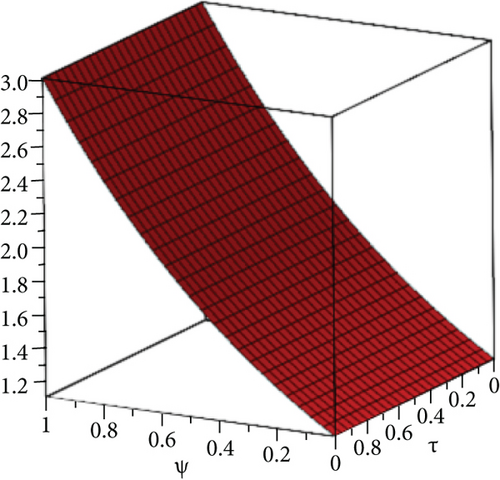
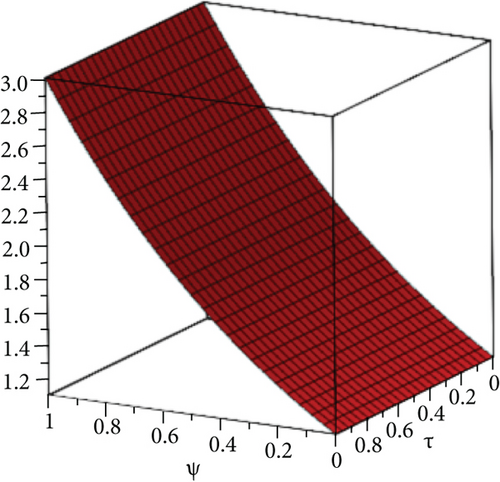
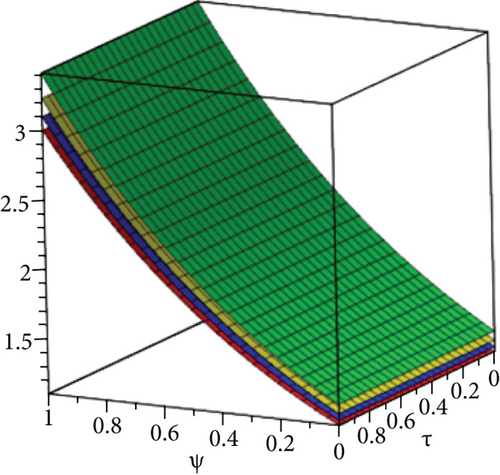

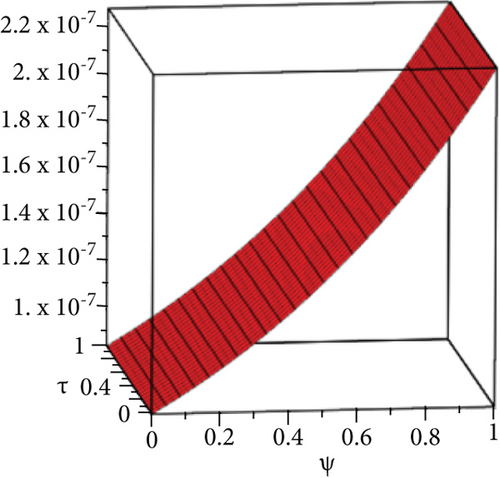
| τ = 0.01 | Absolute error | Absolute error | Exact solution | Our methods’ solution | Absolute error |
|---|---|---|---|---|---|
| ψ | σ = 0.8 | σ = 0.9 | σ = 1 | σ = 1 | σ = 1 |
| 0 | 5.2118400000E-04 | 5.0962000000E-05 | 1.0100501670000 | 1.0100501670000 | 0.00000000E+00 |
| 0.1 | 5.7599800000E-04 | 5.6322000000E-05 | 1.1162780700000 | 1.1162780700000 | 0.00000000E+00 |
| 0.2 | 6.3657500000E-04 | 6.2245000000E-05 | 1.2336780600000 | 1.2336780600000 | 0.00000000E+00 |
| 0.3 | 7.0352500000E-04 | 6.8792000000E-05 | 1.3634251140000 | 1.3634251140000 | 0.00000000E+00 |
| 0.4 | 7.7751600000E-04 | 7.6027000000E-05 | 1.5068177850000 | 1.5068177850000 | 0.00000000E+00 |
| 0.5 | 8.5928700000E-04 | 8.4022000000E-05 | 1.6652911950000 | 1.6652911950000 | 0.00000000E+00 |
| 0.6 | 9.4965800000E-04 | 9.2858000000E-05 | 1.8404313990000 | 1.8404313980000 | 1.00000000E-09 |
| 0.7 | 1.0495350000E-03 | 1.0262400000E-04 | 2.0339912590000 | 2.0339912580000 | 1.00000000E-09 |
| 0.8 | 1.1599150000E-03 | 1.1341700000E-04 | 2.2479079870000 | 2.2479079860000 | 1.00000000E-09 |
| 0.9 | 1.2819060000E-03 | 1.2534600000E-04 | 2.4843225330000 | 2.4843225330000 | 0.00000000E+00 |
| 1.0 | 1.4167240000E-03 | 1.3852800000E-04 | 2.7456010150000 | 2.7456010140000 | 1.00000000E-09 |
+
Example 2. Consider one-dimension fractional-order gas dynamic equation [56]
On taking Jafari-Yang transformation of Equation (63), we get
We get by using the Jafari-Yang transform’s differential property
By applying inverse Jafari-Yang transform to Equation (67)
Now, applying the abovementioned homotopy perturbation technique as in (23), we obtain
Comparing the same power coefficient of ε, we obtain
By taking ε⟶1, we obtain the convergence series type result is given as
When σ = 1, the HPYTM solution is
The analytical results by YTDM
On taking Jafari-Yang transformation of Equation (63), we obtain
By inverse Jafari-Yang transform of Equation (76)
Assuming the unknown ν(ψ, τ) function has the following infinite series form solution:
The Adomian polynomials and , as well as the non-linear term, have been described. Applying specific function, Equation (77) may be determined as
According to Equation (34), the nonlinear function can be found with the help of Adomian polynomials is given as
Thus, on comparing both sides of Equation (79)
For k = 0
For k = 1
For k = 2
The remaining YTDM solution elements ρk for (k ≥ 3) are similarly simple to get. As a result, the solution in series form is as
When σ = 1, the solution by YTDM is
In closed form, the exact solution is
Figure 3(a) shows the solution graph for different values of σ = 1, 0.9, 0.8, 0.7 and 0 ≤ ψ, ϕ ≥ 1 of Example 2 and Figure 3(b), respectively, at ϕ = 0.5, τ ∈ [0, 1] and 0 ≤ ψ ≥ 1 while Figure 3(c) shows the error graph. It is verified from the figures that HPYTM and YTDM solution is closely related with the exact solution.
Example. 3. Consider two-dimension fractional-order diffusion equation [54]
Taking Jafari-Yang transformation to Equation (88), we get
We get by using the Jafari-Yang transform’s differential property
By applying inverse Jafari-Yang transform to Equation (91)
Now, using the abovementioned homotopy perturbation technique as in (23), we get
Comparing the same power coefficient of ε, we obtain
By taking ε⟶1, we obtain convergence series type result is
When σ = 1, the HPYTM solution is
The analytical results by YTDM
Taking Jafari-Yang transformation of Equation (88), we obtain
We get by using the Jafari-Yang transform’s differential property
By inverse Jafari-Yang transform of Equation (99)
Assuming the unknown ν(ψ, ϕ, τ) function has the following infinite series form solution:
Thus, on comparing both sides of Equation (101)
For k = 0
For k = 1
For k = 2
For k = 3
The remaining YTDM solution elements ρk for (k ≥ 3) are similarly simple to get. As a result, the solution in series form is as
When σ = 1, the solution by YTDM is
In closed form, the exact solution is:
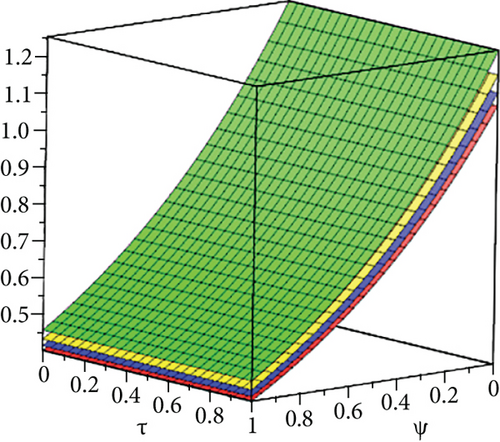
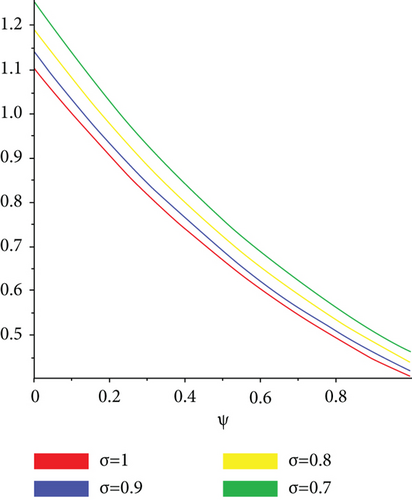
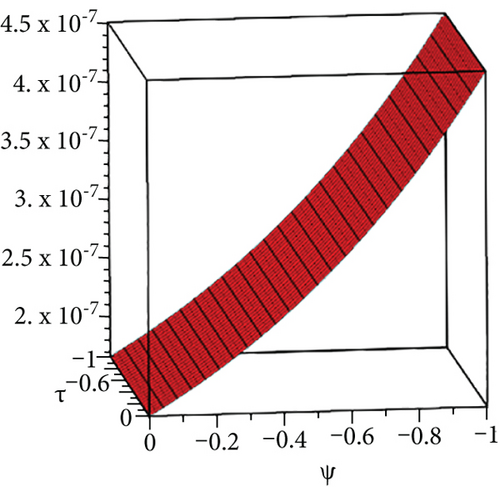
The exact solution shown in Figures 4(a) and 4(b) shows HPYTM and YTDM solutions at σ = 1 and 0 ≤ ψ, ϕ ≥ 1. Figure 5(a) shows the error graph for different values of σ = 1,0.8,0.6,0.5 and 0 ≤ ψ, ϕ ≥ 1 of Example 3 and Figure 5(d) respectively, at ϕ = 0.5, τ ∈ [0, 1] and 0 ≤ ψ ≥ 1 while Figure 5(e) shows the error graph. From the figures and Table 2, it is clear that HPYTM and YTDM solution shows strong agreement with the exact solutions of the problem.
Example 4. Consider three-dimension fractional-order diffusion equation [54]
Taking Jafari-Yang transformation of Equation (110), we get
We get by using the Jafari-Yang transform’s differential property
By applying inverse Jafari-Yang transform to Equation (113)
Now, using the abovementioned homotopy perturbation technique as in (23), we obtain
Comparing the same power coefficient of ε, we get
By taking ε⟶1, we obtain the convergence series type result is given as
When σ = 1, then the HPYTM solution in a closed form:
The analytical results by YTDM
Taking Jafari-Yang transformation of Equation (110), we obtain
We get by using the Jafari-Yang transform’s differential property
by inverse Jafari-Yang transform of Equation (121)
Assuming the unknown ν(ψ, ϕ, φ, τ) function has the following infinite series form solution:
Thus, on comparing both sides of Equation (124)
For k = 0
For k = 1
For k = 2
For k = 3
The remaining YTDM solution elements ρk for (k ≥ 3) are similarly simple to get. As a result, the solution in series form is as
When σ = 1, then the closed form solution by YTDM
In closed form, the exact solution is
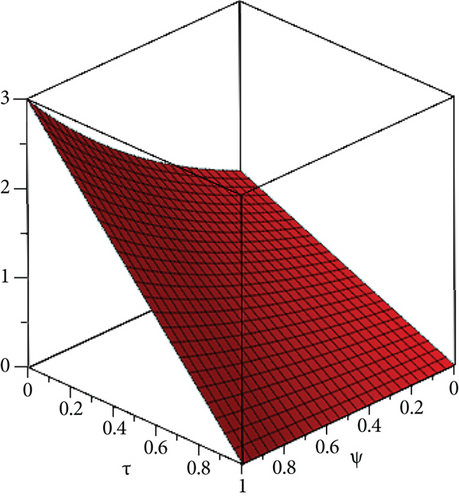
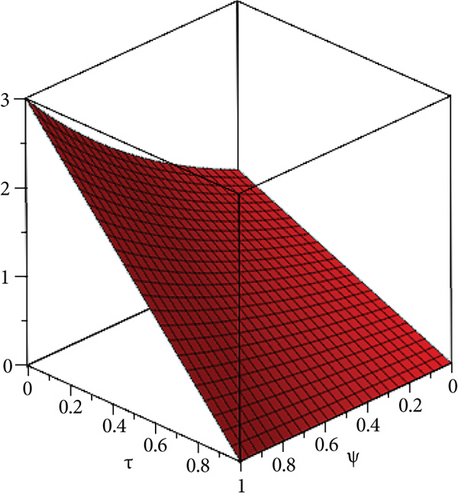
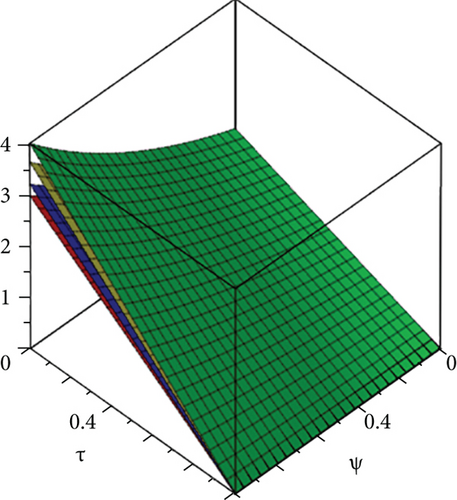

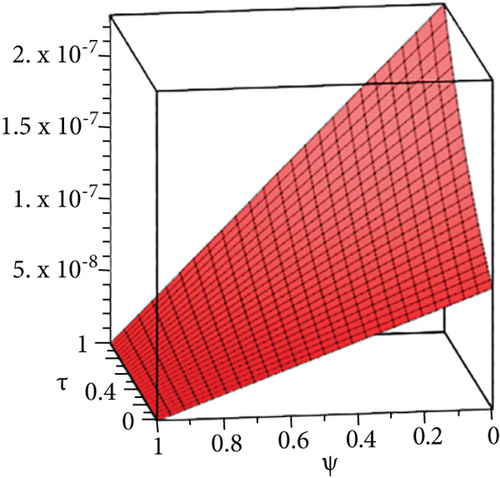
| τ = 0.01 | Exact solution | Our methods’ solution | AE of our methods | AE of our methods | AE of our methods |
|---|---|---|---|---|---|
| ψ | σ = 1 | σ = 1 | σ = 1 | σ = 0.9 | σ = 0.8 |
| 0 | 0.505025083500000 | 0.505025083500000 | 0.0000000000E+00 | 2.5480900000E-05 | 2.6059160000E-04 |
| 0.1 | 0.558139035000000 | 0.558139035100000 | 1.0000000000E-10 | 2.8160900000E-05 | 2.8799840000E-04 |
| 0.2 | 0.616839030000000 | 0.616839029800000 | 2.0000000000E-10 | 3.1122300000E-05 | 3.1828710000E-04 |
| 0.3 | 0.681712557000000 | 0.681712557200000 | 2.0000000000E-10 | 3.4395800000E-05 | 3.5176210000E-04 |
| 0.4 | 0.753408892500000 | 0.753408892700000 | 2.0000000000E-10 | 3.8013200000E-05 | 3.8875720000E-04 |
| 0.5 | 0.832645597500000 | 0.832645597600000 | 1.0000000000E-10 | 4.2011000000E-05 | 4.2964300000E-04 |
| 0.6 | 0.920215699500000 | 0.920215699100000 | 4.0000000000E-10 | 4.6428800000E-05 | 4.7482850000E-04 |
| 0.7 | 1.016995630000000 | 1.016995629000000 | 1.0000000000E-09 | 5.1311000000E-05 | 5.2476600000E-04 |
| 0.8 | 1.123953994000000 | 1.123953993000000 | 1.0000000000E-09 | 5.6708000000E-05 | 5.7995600000E-04 |
| 0.9 | 1.242161266000000 | 1.242161267000000 | 1.0000000000E-09 | 6.2673000000E-05 | 6.4095200000E-04 |
| 1.0 | 1.372800508000000 | 1.372800507000000 | 1.0000000000E-09 | 6.9263000000E-05 | 7.0836100000E-04 |
In Figures 6(a) and 6(b), we consider fixed order σ = 1 for piecewise approximation values of ψ, ϕ in the domain 0 ≤ ψ, ϕ ≥ 10 and = 1 . Figure 7(a) shows error graph and Figure 7(b) represents HPYTM and YTDM solution at σ = 0.6 of Example 4. It is verified from the Figures 6(a) and 6(b) and Table 3 that HPYTM and YTDM solution is closely related with the exact solution.


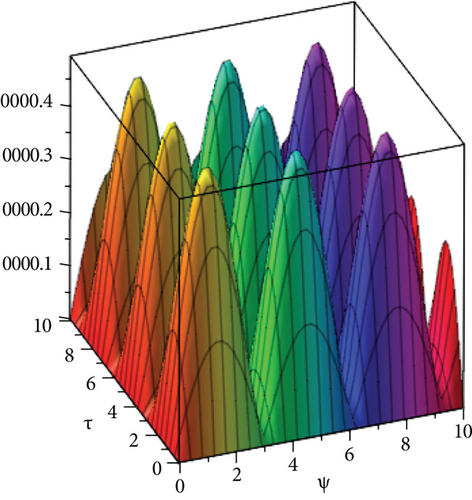
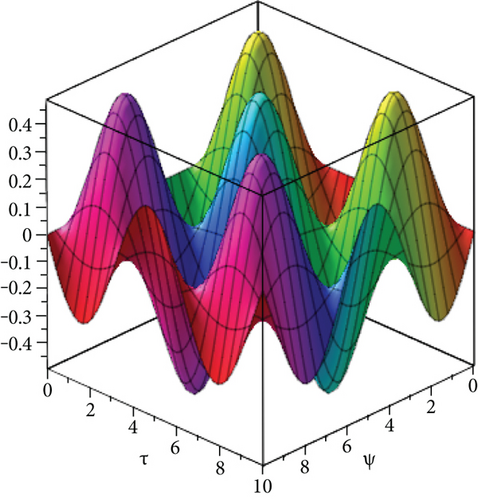
| τ = 0.01 | Exact solution | Our methods’ solution | AE of our methods | AE of our methods | AE of our methods |
|---|---|---|---|---|---|
| ψ | σ = 1 | σ = 1 | σ = 1 | σ = 0.9 | σ = 0.8 |
| 0 | 0.00000000000000 | 0.00000000000000 | 0.000000000E+00 | 0.000000000E+00 | 0.000000000E+00 |
| 0.1 | 0.039084756460000 | 0.039084756470000 | 8.4147098480E-12 | 5.8916348320E-06 | 6.0179783350E-05 |
| 0.2 | 0.077778990960000 | 0.077778990980000 | 1.6829419700E-11 | 1.1724408770E-05 | 1.1975827680E-04 |
| 0.3 | 0.115696083500000 | 0.115696083500000 | 0.0000000000E+00 | 1.7440075190E-05 | 1.7814016480E-04 |
| 0.4 | 0.152457179000000 | 0.152457179000000 | 0.0000000000E+00 | 2.2981414070E-05 | 2.3474221550E-04 |
| 0.5 | 0.187694972800000 | 0.187694972800000 | 8.4147098480E-11 | 2.8293115510E-05 | 2.8899866580E-04 |
| 0.6 | 0.221057380400000 | 0.221057380400000 | 0.0000000000E+00 | 3.3322251000E-05 | 3.4036760840E-04 |
| 0.7 | 0.252211055800000 | 0.252211055900000 | 8.4147098480E-11 | 3.8018332270E-05 | 3.8833574600E-04 |
| 0.8 | 0.280844721700000 | 0.280844721700000 | 8.4147098480E-11 | 4.2334573540E-05 | 4.3242369270E-04 |
| 0.9 | 0.306672279900000 | 0.306672280000000 | 8.4147098480E-11 | 4.6227807340E-05 | 4.7219102240E-04 |
| 1.0 | 0.329435670100000 | 0.329435670200000 | 8.4147098480E-11 | 4.9659157730E-05 | 5.0724039260E-04 |
6. Conclusion
In the present article, different analytical techniques are used to show the fractional view analysis of diffusion equations. In Caputo, manner fractional derivative is considered. The suggested techniques are tested to solve fractional-order diffusion equations. It is observed that the suggested techniques are the best tool for investigating fractional partial differential equations. The close relation between the exact and analytical results is confirmed by the plotted graphs. The given methods give series form solution which have higher convergence rate towards the exact results. It is also shown that both methods give same solution for the proposed problems. Finally, both proposed methods are very methodical and efficient and may be used to investigate nonlinear physical problems related to physics of plasmas such as modeling nonlinear unmodulated and modulated structures. Moreover, the obtained results/solutions can be useful in investigating the diffusion characteristics of some plasmas and fluids.
Conflicts of Interest
The authors declare that there are no conflicts of interest regarding the publication of this article.
Acknowledgments
The authors express their gratitude to Princess Nourah Bint Abdulrahman University Researchers Supporting Project (Grant No. PNURSP2022R17), Princess Nourah Bint Abdulrahman University, Riyadh, Saudi Arabia.
Open Research
Data Availability
The numerical data used to support the findings of this study are included within the article.




